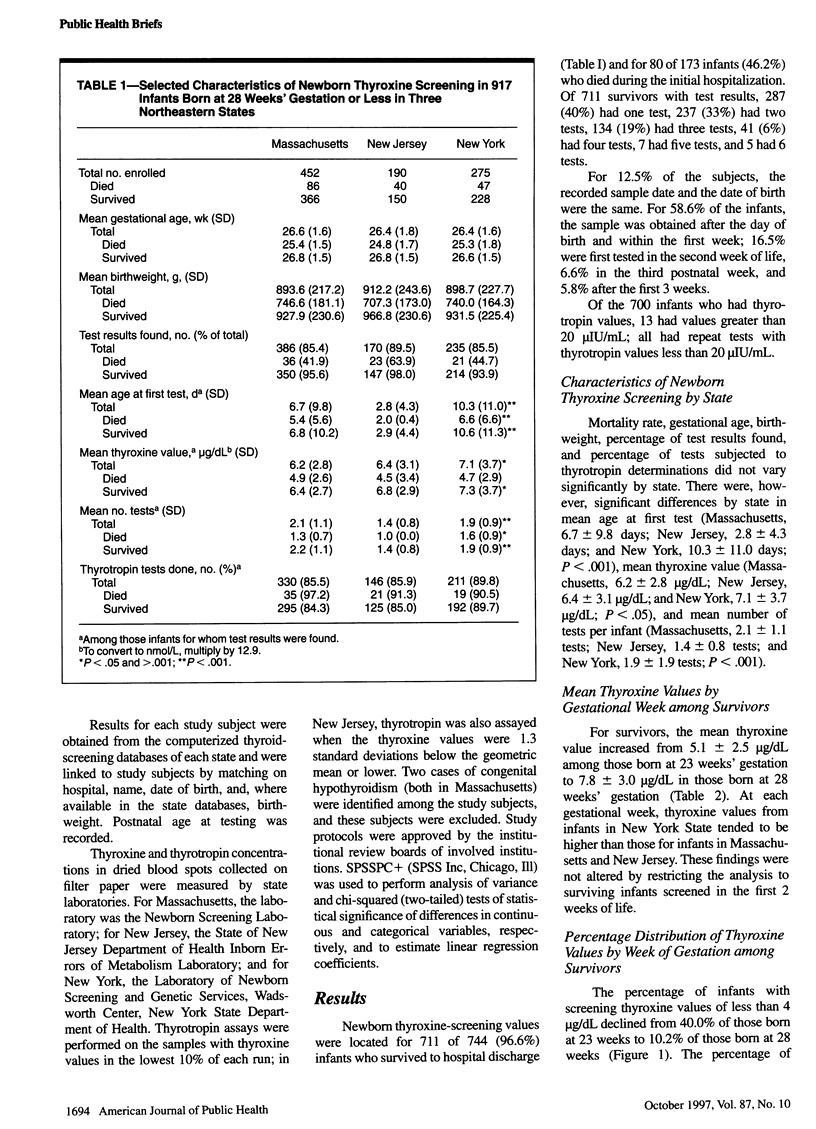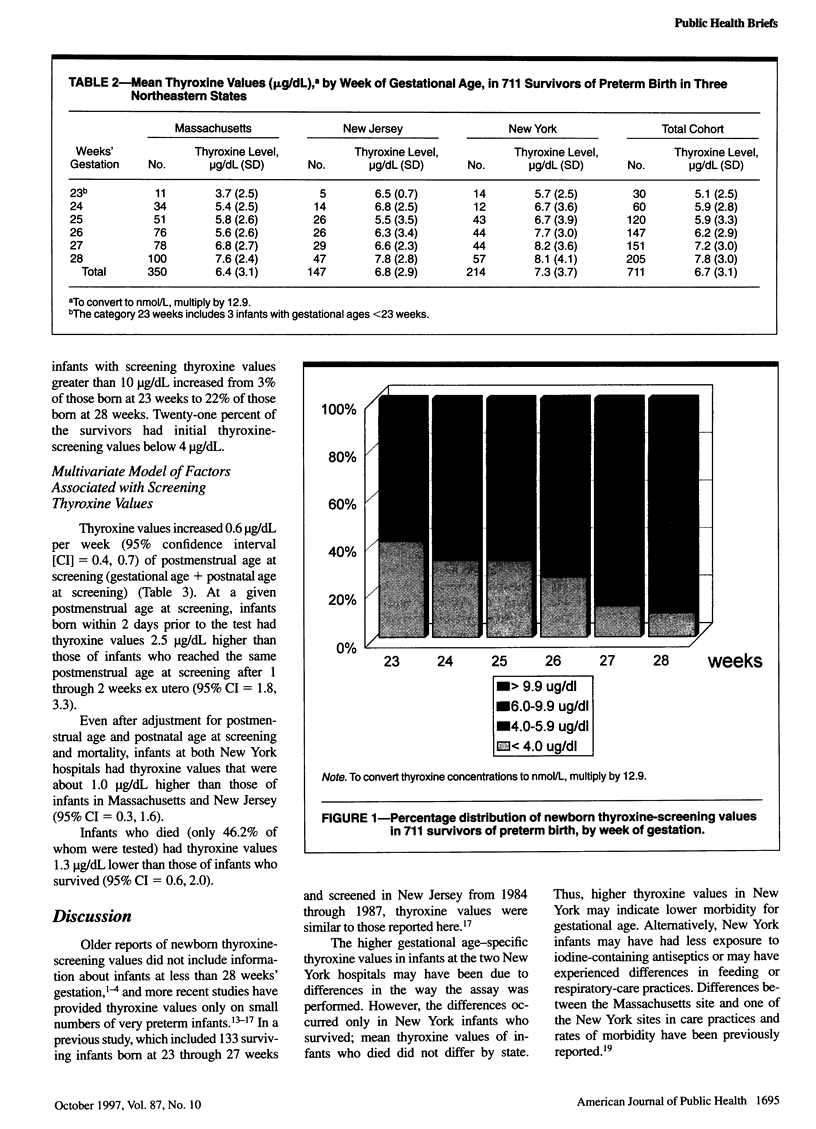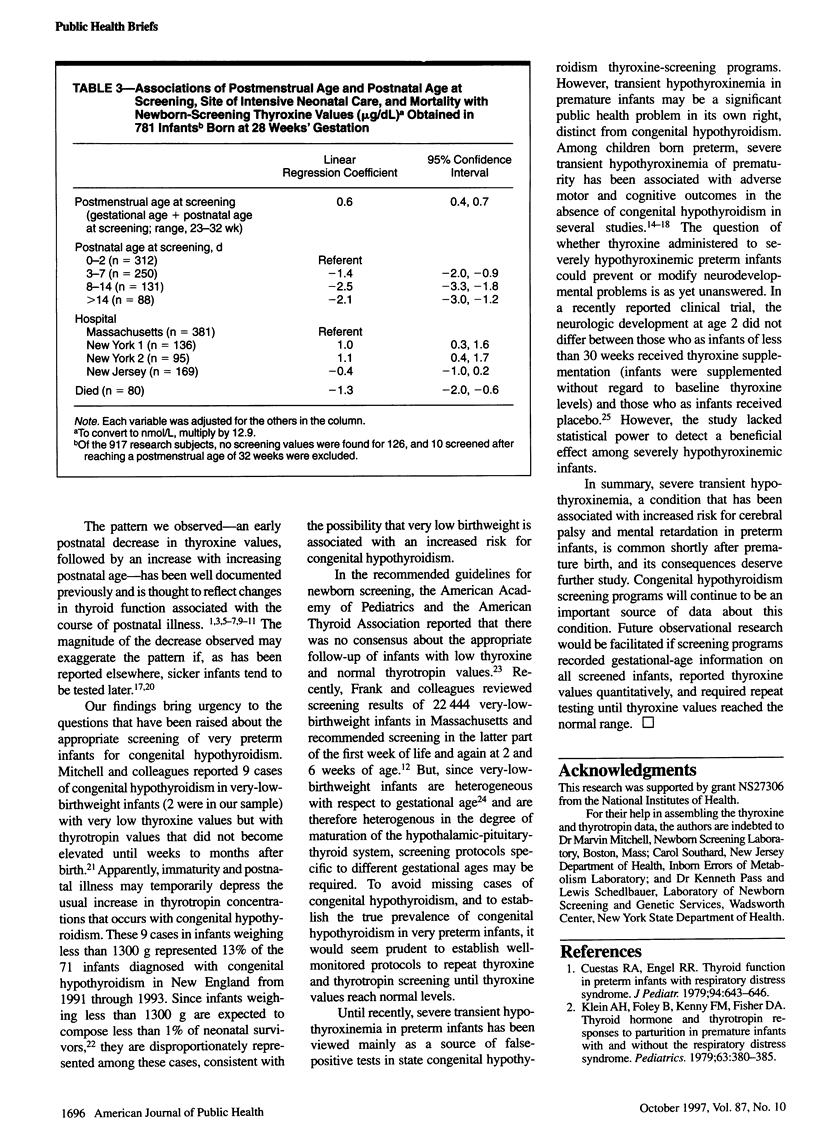Abstract
OBJECTIVES: Severe transient hypothyroxinemia in premature infants is associated with cerebral palsy and mental retardation: this study assessed its prevalence in very premature infants. METHODS: Congenital hypothyroidism screening programs in three states provided thyroxine values for 919 newborn infants younger than 29 weeks who were enrolled in a multicenter study. RESULTS: Thyroxine values were lower than 4.0 micrograms/dL in 21% of survivors and increased each week by 0.6 microgram/dL (95% confidence interval [CI] = 0.4, 0.7). At tests done 1 to 2 days after birth, levels were 2.5 micrograms/dL higher (95% CI = 1.8, 3.3) than at tests done at 8 to 14 days. In New York, levels were 1.0 microgram/dL higher (95% CI = 0.3, 1.6) than elsewhere. The levels of infants who died were 1.3 micrograms/dL lower (95% CI = 0.6, 2.0) than those of survivors. CONCLUSIONS: Severe transient hypothyroxinemia is common in very premature infants and deserves further study.
Full text
PDF




Selected References
These references are in PubMed. This may not be the complete list of references from this article.
- Adams L. M., Emery J. R., Clark S. J., Carlton E. I., Nelson J. C. Reference ranges for newer thyroid function tests in premature infants. J Pediatr. 1995 Jan;126(1):122–127. doi: 10.1016/s0022-3476(95)70514-7. [DOI] [PubMed] [Google Scholar]
- Avery M. E., Tooley W. H., Keller J. B., Hurd S. S., Bryan M. H., Cotton R. B., Epstein M. F., Fitzhardinge P. M., Hansen C. B., Hansen T. N. Is chronic lung disease in low birth weight infants preventable? A survey of eight centers. Pediatrics. 1987 Jan;79(1):26–30. [PubMed] [Google Scholar]
- Cuestas R. A., Engel R. R. Thyroid function in preterm infants with respiratory distress syndrome. J Pediatr. 1979 Apr;94(4):643–646. doi: 10.1016/s0022-3476(79)80042-6. [DOI] [PubMed] [Google Scholar]
- Den Ouden A. L., Kok J. H., Verkerk P. H., Brand R., Verloove-Vanhorick S. P. The relation between neonatal thyroxine levels and neurodevelopmental outcome at age 5 and 9 years in a national cohort of very preterm and/or very low birth weight infants. Pediatr Res. 1996 Jan;39(1):142–145. doi: 10.1203/00006450-199601000-00021. [DOI] [PubMed] [Google Scholar]
- Eggermont E., Vanderschueren-Lodeweyckx M., De Nayer P., Smeets E., Vanacker G., Cornette C., Jaeken J., Devlieger H., Eeckels R., Beckers C. The thyroid-system function in preterm infants of postmenstrual ages of 31 weeks or less: evidence for a "transient lazy thyroid system". Helv Paediatr Acta. 1984 Aug;39(3):209–222. [PubMed] [Google Scholar]
- Etling N., Padovani E., Gehin-Fouque F., Tato L. Serum and urine thyroid hormone levels in healthy preterm and small for date infants on the first and fifth day of life. Helv Paediatr Acta. 1984 Aug;39(3):223–230. [PubMed] [Google Scholar]
- Fernhoff P. M., Brown A. L., Elsas L. J. Congenital hypothyroidism: increased risk of neonatal morbidity results in delayed treatment. Lancet. 1987 Feb 28;1(8531):490–491. doi: 10.1016/s0140-6736(87)92098-8. [DOI] [PubMed] [Google Scholar]
- Frank J. E., Faix J. E., Hermos R. J., Mullaney D. M., Rojan D. A., Mitchell M. L., Klein R. Z. Thyroid function in very low birth weight infants: effects on neonatal hypothyroidism screening. J Pediatr. 1996 Apr;128(4):548–554. doi: 10.1016/s0022-3476(96)70368-2. [DOI] [PubMed] [Google Scholar]
- Franklin R. C., Purdie G. L., O'Grady C. M. Neonatal thyroid function: prematurity, prenatal steroids, and respiratory distress syndrome. Arch Dis Child. 1986 Jun;61(6):589–592. doi: 10.1136/adc.61.6.589. [DOI] [PMC free article] [PubMed] [Google Scholar]
- Fuse Y., Shimizu M., Uga N., Fujii T., Irie M. Maturation of feedback control of thyrotropin in premature infants. J Dev Physiol. 1990 Jul;14(1):17–22. [PubMed] [Google Scholar]
- Harkavy K. L., Enecio C. E. Free thyroxine levels in hospitalized newborns: depressed levels in critical, nonthyroidal illness. J Perinatol. 1991 Jun;11(2):117–121. [PubMed] [Google Scholar]
- John R., Bamforth F. J. Serum free thyroxine and free triiodothyronine concentrations in healthy fullterm, preterm and sick preterm neonates. Ann Clin Biochem. 1987 Sep;24(Pt 5):461–465. doi: 10.1177/000456328702400506. [DOI] [PubMed] [Google Scholar]
- Klein A. H., Foley B., Kenny F. M., Fisher D. A. Thyroid hormone and thyrotropin responses to parturition in premature infants with and without the respiratory distress syndrome. Pediatrics. 1979 Mar;63(3):380–385. [PubMed] [Google Scholar]
- Lucas A., Morley R., Fewtrell M. S. Low triiodothyronine concentration in preterm infants and subsequent intelligence quotient (IQ) at 8 year follow up. BMJ. 1996 May 4;312(7039):1132–1134. doi: 10.1136/bmj.312.7039.1132. [DOI] [PMC free article] [PubMed] [Google Scholar]
- Lucas A., Rennie J., Baker B. A., Morley R. Low plasma triiodothyronine concentrations and outcome in preterm infants. Arch Dis Child. 1988 Oct;63(10):1201–1206. doi: 10.1136/adc.63.10.1201. [DOI] [PMC free article] [PubMed] [Google Scholar]
- Meijer W. J., Verloove-Vanhorick S. P., Brand R., van den Brande J. L. Transient hypothyroxinaemia associated with developmental delay in very preterm infants. Arch Dis Child. 1992 Jul;67(7):944–947. doi: 10.1136/adc.67.7.944. [DOI] [PMC free article] [PubMed] [Google Scholar]
- Mercado M., Yu V. Y., Francis I., Szymonowicz W., Gold H. Thyroid function in very preterm infants. Early Hum Dev. 1988 Mar;16(2-3):131–141. doi: 10.1016/0378-3782(88)90093-x. [DOI] [PubMed] [Google Scholar]
- Mitchell M. L., Walraven C., Rojas D. A., McIntosh K. F., Hermos R. J. Screening very-low-birthweight infants for congenital hypothyroidism. Lancet. 1994 Jan 1;343(8888):60–61. doi: 10.1016/s0140-6736(94)90918-0. [DOI] [PubMed] [Google Scholar]
- Power C. National trends in birth weight: implications for future adult disease. BMJ. 1994 May 14;308(6939):1270–1271. doi: 10.1136/bmj.308.6939.1270. [DOI] [PMC free article] [PubMed] [Google Scholar]
- Reuss M. L., Clark C. J., Paneth N. Efficiency of sampling: birthweight and gestational age distributions in two cohorts, < 31 weeks and 500-1499 grams. Paediatr Perinat Epidemiol. 1995 Jul;9(3):341–350. doi: 10.1111/j.1365-3016.1995.tb00151.x. [DOI] [PubMed] [Google Scholar]
- Reuss M. L., Paneth N., Pinto-Martin J. A., Lorenz J. M., Susser M. The relation of transient hypothyroxinemia in preterm infants to neurologic development at two years of age. N Engl J Med. 1996 Mar 28;334(13):821–827. doi: 10.1056/NEJM199603283341303. [DOI] [PubMed] [Google Scholar]
- van Wassenaer A. G., Kok J. H., de Vijlder J. J., Briët J. M., Smit B. J., Tamminga P., van Baar A., Dekker F. W., Vulsma T. Effects of thyroxine supplementation on neurologic development in infants born at less than 30 weeks' gestation. N Engl J Med. 1997 Jan 2;336(1):21–26. doi: 10.1056/NEJM199701023360104. [DOI] [PubMed] [Google Scholar]


